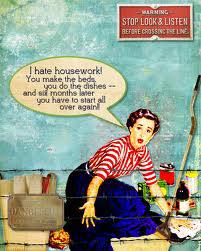 I’m an odd choice to write about housework because I hate doing it and I will really procrastinate. But I also like a clean house and when our place falls to pieces I start to feel a little crazy… and I know it’s time to clean house.
I’m an odd choice to write about housework because I hate doing it and I will really procrastinate. But I also like a clean house and when our place falls to pieces I start to feel a little crazy… and I know it’s time to clean house.
I grew up in a very spic ‘n span household. My mom’s cleaning closet contained; Resolve Carpet Cleaner, Windex, Scrubbing Bubbles, and Comet for the bathroom among the silver polish, rag bags, and dusters. These familiar labels were the ones I bought when I started to clean my own apartment in my twenties.
It never occurred to me to ask What was in the stuff? Sure I’d get headaches or feel a little dizzy after a particularly intense cleaning blitz. I figured it was due to a late night of partying–the very reason I was atoning with housework.
When my kids were small we attempted to sell our condo, which was on the market for a year. We had twenty-five Open Houses. Yes, I have visited the inner circle of hell and it is the State of Perpetual Open Houses with Young Children. I was cleaning constantly.
One day, preparing for a realtor to show our apartment AGAIN, I cleaned ferociously before sweeping us out the door.
A few hours later I brought the kids back from the playground, and I was shocked when I opened the front door. The cleaning fumes were horrible!This didn’t smell clean; this smelled like a toxic waste site. This can’t be good for any of us, I thought.
So, what’s in this stuff?
Take a look… I dare you. Turn the bottle over and read the tiny print. Unless you have an advanced chemistry degree, you will be stumped by alphabet soup. DEGBE. Isobutane. Perchloroethylane. Sodium Hydroxide. I didn’t know what any of that was. Fortunately, more interested and scientific minds had done the work for me.
I looked up the four familiar cleaning products from my childhood.
I started with Resolve Carpet Cleaner, which was a staple in my house filled with dogs and kids. Resolve (and other carpet cleaners) contain:
- Isobutane, which can cause central nervous system (CNS) reactions such as dizziness or respiratory arrest if inhaled or ingested.
- Perchloroethylane, a known human carcinogen that can cause immediate CNS damage, and
- Napthalene, which is toxic to breathe.
Hmmm, I didn’t want my baby crawling around on that.
What about Windex? Didn’t everyone have a cheery, bright blue bottle of spray under their sink? I looked it up and read that small particles could be easily inhaled causing headaches, nausea, or asthma attacks with the possible chronic, long-term effects of cancer chemicals on an unborn child. I kept reading:
- Ammonia in Windex is one of the troublesome ingredients.“When ammonia enters the body as a result of breathing, swallowing or skin contact, it reacts with water to produce ammonium hydroxide. This chemical is very corrosive and damages cells in the body on contact”. Fantastic.
- Coal Tar is commonly used in glass cleaners, as is
- Butyl Cellusolve, which is a neurotoxin.
Why isn’t the woman beaming at her crystal clear sliding door on the Windex commercial wearing a respirator?
Anything wrong with those busy, cute Scrubbing Bubbles to make my bathroom shiny clean and sweet smelling? “These lung-inflaming products contain 10 percent DEGBE, a solvent banned in the European Union at concentrations above 3 percent.”
A neurotoxin, a reproductive toxin, and it can cause liver and kidney damage.
Terrible!
Maybe something old school like Comet would be safer?
Actually, no. Comet contains:
- Sodium Hydroxide, which “is very corrosive and can cause severe burns in all tissues that it comes in contact with,” and
- Bleach, which is one of the deadliest chemicals.
My God, I’m lucky my children weren’t born with six heads!
I got that chemical garbage out of my house and did…nothing. Nothing, that is, until my spic ‘n span mother visited and said, “Well, if you won’t use that carpet cleaner, what are you cleaning the rugs with?”
Indeed. Two kids and a dog…. I would need a better solution.
A search for some less toxic solutions
What could I use to clean my house that wouldn’t make us all sick in the process? As I read online and searched in a few grocery stores, I found there are safer cleaning supplies. I also discovered lots of people were cleaning with very basic, nontoxic household staples, like baking soda.
Here is a simple list of safer, less toxic replacements:
1. Carpet Cleaner: Down East All Purpose Cleaner, ECOgent Carpet Cleaner.
2. Window and Glass Cleaner: Nature Clean Natural Window and Glass Cleaner.
3. Bathroom Cleaner: 20 Mule Team Borax, Arm & Hammer Washing Soda.
4. Abrasive Cleaner: Bon Ami, Down East Scouring Powder.
The safest, nontoxic cleaning supplies are the ones parents are making on their own at home using just a few basic ingredients.
For instance, my friend Megan uses baking soda and half a lemon to clean her bathtub, using the lemon as a scrubber. How ingenious!
Another friend saves her citrus peels in a glass jar of white vinegar for 1-2 weeks, strains the mixture, and uses this to clean all bathroom surfaces including the toilet!
What does clean mean?
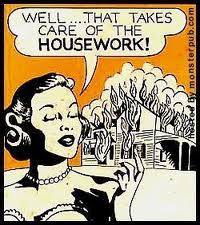 It turns out that you can have a clean house without having to singe your nose hairs with bleach. Unfortunately, my hatred for all things toxic was not going to provide me a further excuse not to clean. But, what clean means to me has changed over the years.
It turns out that you can have a clean house without having to singe your nose hairs with bleach. Unfortunately, my hatred for all things toxic was not going to provide me a further excuse not to clean. But, what clean means to me has changed over the years.
Now, I think of a surface freshly sprayed with Lysol as dirty, in the sense that I don’t want my kids to get Lysol all over their hands or to put toys or food near it. This was a mind shift for sure and not a popular one where I live. Once I started making different choices for my home cleaning products, I immediately noticed what they use at my kids’ schools and felt overwhelmed.
We live in a really toxic world. Sometimes that can make me feel like saying ‘What the hell difference will this make?’ There are so many toxic environmental problems beyond my control–oil refineries, lead smelting plants, fracking, and, in my own backyard, a hospital burning medical waste with coal.
Sigh.
But, as parents we absolutely control what we clean our homes with. In that small world we are in charge.
I like the idea that I am voting with my pocketbook when I choose greener products, and when I simply decide not to spend money on the toxic ones. Toxicity is cumulative. Toxicity causes illness. Health, in our times, is about constantly reducing our toxic load. Keeping these chemicals out of our living environment is within our control and a great step towards healthier living. Real clean; not the fake, pine-scented kind.
So, how about it? Are you ready to take the ‘make one change challenge’ and swap out one toxic cleaning product for something much safer?
Happy green cleaning!
Alison MacNeil is searching for a nontoxic cleaning product that will clean the house for her.
Useful links
Household cleaning agents to avoid
All natural cleaning solutions and recipes:
Photo credit: Adobe Stock #126069348




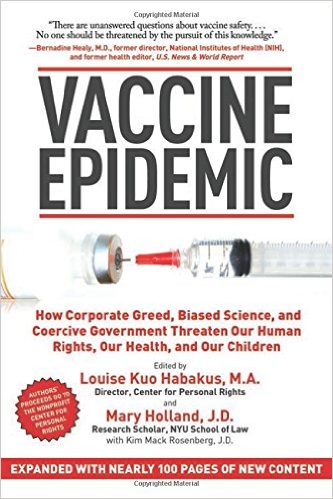


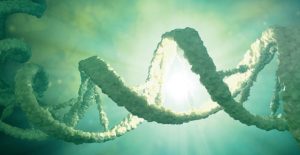

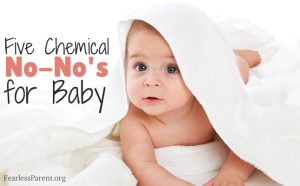

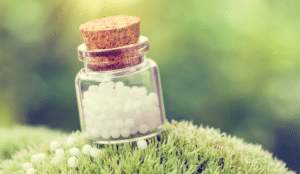
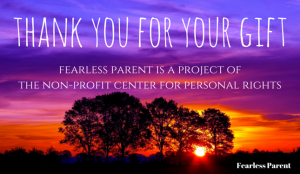
Thieves cleaner is probably one of the least expensive I’ve ever purchased. A 14.5 ounce bottle has lasted me nearly two years. On top of that, studies show it kills 99.6% of bacteria and it smells great!
This too is my favorite with the most value for the money!
thank you for this I too rarely house work(I would rather mow the lawn) but bathrooms I do want clean
Or you could ditch all that other stuff, hunting it down, running out of lemons, lumpy baking soda, etc… and just switch to water… with Norwex!! They changed my life!! Check ’em out here: http://www.norwex.com Happy cleaning! =)
Great article! Lots of good info. Thanks!
Hi Alison, it’s so wonderful that you have discovered the ingredients in chemical sprays & have removed them from your home! ENJO may be just what you are looking for! It’s chemical free cleaning using specially designed fibres & miracles & cold water! They are designed to be machine washed & line dried & effectively remove all kinds of dirt & bacteria for about 3 years! ENJO helps us save time, money, your health & environment! The website is http://www.enjo.com.au & my Facebook page is http://www.facebook.com/NadineMccristalCavenaghENJOpreneur. Please feel free to contact me if you would like to have a chat & see how ENJO can clean in your home! Kind Regards, Nadine
Want to know what works in a bathtub? A plastic (or loofah-based?) scrubbie and some good, plant-based, *dishwashing liquid.*
Yes, the stuff you use to wash dishes by hand.
I am not kidding.
I reasoned that soap scum, the stuff that forms bathtub rings, is mostly *soap*. That even when it scums up like that, it’s usually because it’s mixed with dirt and biological matter, sort of like a dirty dish. I was out of bathtub cleaner (even the natural stuff runs out), so I tried it. Bingo. Cheaper per ounce, too.
Yes, you have to scrub a little, but not as much as you would if you just sprayed all-purpose cleaner. And it spreads around better than Bon Ami. Just be very careful not to use too much. It will foam up as you’re rinsing it out and you’ll take forever making it all gone.
You can *add* Bon Ami to the mix if your bathtub’s really nasty but I found I didn’t need it.
Should be safe for plastic tubs. (It washes plastic dishes.) I have a painted/enameled metal tub so it’s no big deal to me.
Healthy Child Healthy World has some fabulous home made cleaner recipes. I have the book, but I bet it’s on their website. I pretty much clean exclusively with vinegar, Vinegar Rinse (homemade with vinegar, water, and tea tree oil) and All Purpose Cleaner (Homemade–borax, water, and castille soap).
The great benefit of making your own over buying even natural cleaners is you are not buying a bottle of mostly water and you are reusing the plastic spray bottle and thereby helping the Earth even more. They take 5 min. at the most to make, including getting out the ingredients.